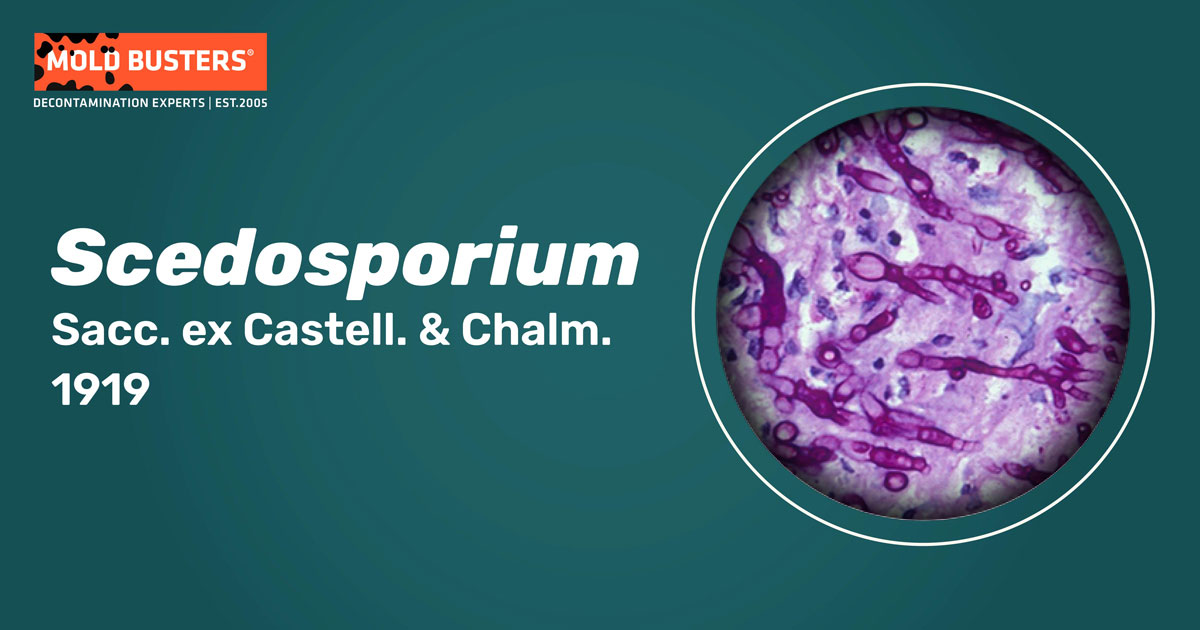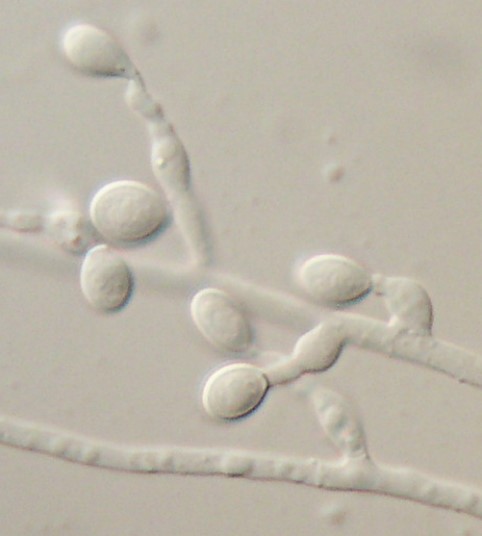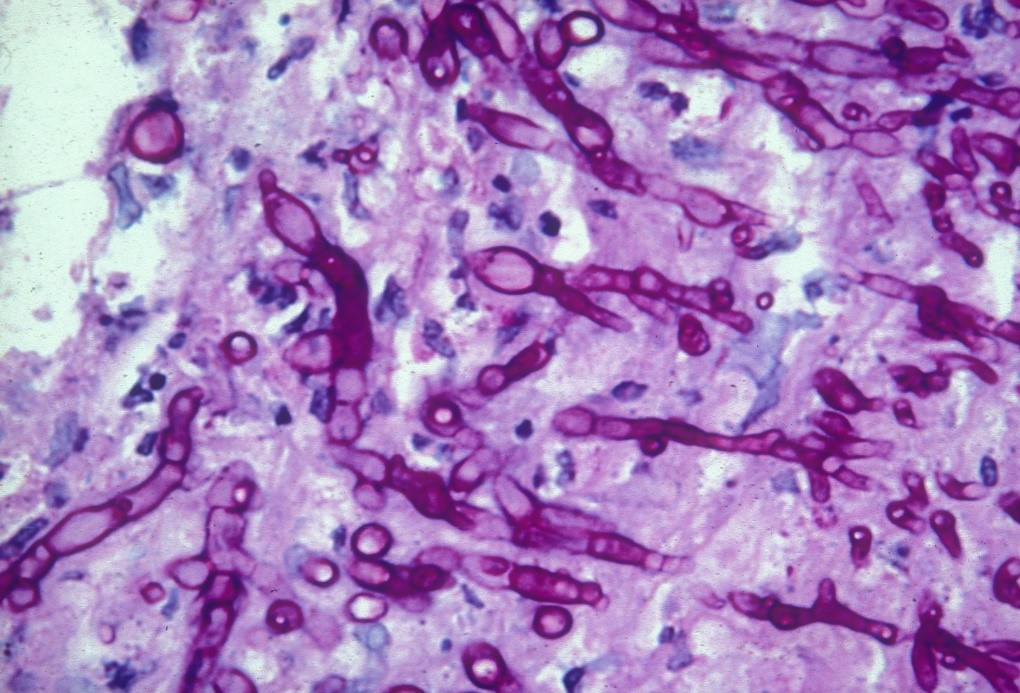Sacc. ex Castell. & Chalm. 1919
What is Scedosporium?
Scedosporium fungi belong to the family Microascaceae, within the phylum Ascomycota. The name Scedosporium was proposed by Saccardo in 1911 and validated by Castellani and Chalmers in 1919 when the species Scedosporium apiospermum was accepted instead of Monosporium apiospermum [1]. Currently, the genus consists of 13 species [2], which are predominantly saprophytes, contaminants of soil for potted plants, and can sometimes act as opportunistic human pathogens [3].

Within filamentous fungi, Scedosporium species are the second most frequent colonizing agent of the airways of cystic fibrosis patients [4]. Nowadays, species are less susceptible to the majority of antifungal drugs, except for voriconazole, which is proposed for treatment against Scedosporium infections [5]. They are mainly present in anthropogenically disturbed and polluted habitats and are not that frequently found in nature. Scedosporium fungi can degrade certain soil pollutants and could be a useful tool in bioremediation [4].
What does Scedosporium look like?
Scedosporium spp. are highly polymorphic and produce several different types of asexual states (synanamorphs), which differ in conidial formation [1]. Conidia are obovoid to sub-cylindrical conidia, generally 5–14 µm long and 2–5 µm wide (Fig. 1). The sexual stage is known as Pseudallescheria [6] and produces dark, non-ostiolate globose ascomata with 8-spored asci.
Ascospores are unicellular, yellow to reddish-brown, fusiform to ellipsoidal [1]. S. apiospermum and S. boydii form downy to cottony, white-grey colonies, that later turn into dark grey or smoky brown, with dark brown to grey reverse. S. aurantiacum forms dense, cottony to lanose, yellow-grey and brown-grey colonies with concentric zones and brown to brown-orange reverse. S. dehoogii forms cottony, white to pale grey colonies with colorless reverse. S. prolificans form downy to cottony, olive-grey to black colonies, with white-colored mycelial tufts and dark brown-grey reverse [7].

Where can be Scedosporium found?
Scedosporium species are thermotolerant and therefore are usually found in soils in temperate climates and sometimes in the tropics [4]. Through years species have been isolated from various substrates, mainly from anthropogenically influenced habitats, like industrial areas, agricultural lands (soil and livestock, poultry or cattle manure), oil-soaked soils, sewage, polluted waters, city parks, and playgrounds [3,4,8].
The most suitable soils for its growth are nitrogen-rich soils, with a moderate phosphorus amount, and with a pH in the range of 7.0 to 7.6. Scedosporium species can survive at high salt concentrations and high osmotic pressure [3]. Most of the species grow on 40°C (104°F), but S. aurantiacum and S. prolificans grow also on 45°C (113°F).
Species are detected in natural habitats but are less frequent. Scedosporium species are detected in the guano of bats, chickens, and blackbirds, in amphibian and pigeon intestines, lizard lungs, and donkey pharynx. In the Indian and Nepalese bamboo plantations, S. boydii was isolated from rat burrows. Recently it was discovered that Scedosporium spp. are symbionts of wood-eating insects (e.g. Nasutitermes sp) helping them in the degradation of plant cells [4].
How many Scedosporium species exist?
Currently, 13 species are recognized, with Scedosporium apiospermum as the most common species, followed by S. boydii and S. aurantiacum [3]. S. apiospermum and S. boydii are worldwide distributed [8], with S. apiospermum being dominant in Bangkok, Mexico, Austria and The Netherlands, S. dehoogii was dominant in Western France, while S. aurantiacum was prevalent in Australia [3]. Strains among different Scedosporium species are highly genetically variable, except from S. prolificans which is relatively homogeneous [6].
Is Scedosporium present indoors?
Scedosporium spp. are rarely present in the indoor environment but were mostly isolated from the soil of potted plants. Therefore, potted plants need to be removed from the home of patients suffering from chronic pulmonary diseases, such as cystic fibrosis, as well as from medical facilities [4].
Is Scedosporium harmful to humans?
Scedosporium spp. cause a wide range of infections, such as osteomyelitis, sinusitis, keratitis, subcutaneous mycetoma, lymphocutaneous-, oculus-, and bone and joint infection, predominantly as opportunists (Fig. 2) [1,3,8]. They are the dominant causal agent of white grain mycetoma worldwide [1]. Scedosporium spp. infect patients with cystic fibrosis [3]. In immunocompromised patients, they cause allergic bronchitis and can lead to disseminated diseases and central nervous system infections [1], while patients with healthy immune systems may be asymptomatically colonized or locally infected [8]. Infections mostly occur when a wound is in touch with contaminated materials (e.g., wood chips) [1].

How to treat Scedosporium infections?
Through the years Scedosporium species have shown a decreased susceptibility to many antifungal drugs, making successful treatment complicated. Species S. apiospermum and S. boydii displayed variable susceptibility, depending on strains characteristics, while S. aurantiacum was less susceptible to almost every antifungal drug, apart from voriconazole [1]. In general, voriconazole is proposed as a reliable solution for treatment against Scedosporium infections [5], sometimes combined with surgical intervention [8]. Combination of voriconazole with amphotericin B or echinocandins had a good effect on S. apiospermum. For future application, N-chlorotaurine (NCT) showed promising antifungal and anti-inflammatory properties and affects a broad range of microorganisms [8].
Scedosporium species as bioremediation agents
Scedosporium species can degrade aliphatic and aromatic pollutants. Aliphatic pollutants are long-chained organic compounds such as ethylene, acetylene, and propane, while aromatic compounds are cyclic pollutants such as petroleum and oil. S. boydii can convert aliphatic compounds into less toxic intermediate compounds, which are easier to manage.
Scedosporium species are capable to utilize carbon from aromatic pollutants and use them as food sources. Having these degrading properties, species from this genus (in form of Biovitis SA product) are used for bioremediation of livestock manure and nutrient-rich effluents. Furthermore, Scedosporium species can degrade cellulose, and therefore could be used to speed up the composting process and promote composting at lower temperatures [4].

Did you know?
Chaetomium is the 2nd common toxic mold type found in homes we tested?! Find out more exciting mold stats and facts inside our mold statistics page.
References
- Abrantes RA, Refojo N, Hevia AI, Fernández J, Isla G, Córdoba S, Dávalos MF, Lubovich S, Maldonado I, Davel GO, Stchigel AM (2021). Scedosporium from Clinical Setting in Argentina, with the Proposal of the New Pathogenic Species Scedosporium americanum. Journal of Fungi, 7, 160.
- Retrieved from (nov 2021) speciesfungorum.org
- Mouhajir A, Poirier W, Angebault C, Rahal E, Bouabid R, Bougnoux M-E, Kobi A, Zouhair R, Bouchara J-P, Giraud S (2020). Scedosporium species in soils from various biomes in Northwestern Morocco. PLoS ONE, 15(2): e0228897.
- Rougeron A, Giraud S, Alastruey-Izquierdo A, Cano-Lira J, Rainer J, Mouhajir A, Le Gal S, Nevez G, Meyer W, Bouchara, JP (2018). Ecology of Scedosporium Species: Present Knowledge and Future Research. Mycopathologia, 183:185–200.
- Lackner M, Hagen F, Meis JF, Gerrits van den Ende AHG, Vu D, Robert V, Fritz J, Moussa TAA, de Hoog GS (2014). Susceptibility and Diversity in the Therapy-Refractory Genus Scedosporium. Antimicrobial Agents and Chemotherapy, 58 (10): 5877–5885.
- Lu Q, Gerrits van den Ende AHG, Bakkers J M J E, Sun J, Lackner M, Najafzadeh MJ, Melchers WJG, Li R, de Hoog GS (2011). Identification of Pseudallescheria and Scedosporium species by three molecular methods. Journal of Clinical Microbiology, 49(3):960-967.
- Ramsperger M, Duan S, Sorrell TC, Meyer W, Chen S (2014). The Genus Scedosporium and Pseudallescheria: Current Challenges in Laboratory Diagnosis. Current Clinical Microbiology Reports, 1:27–36.
- Ramirez-Garcia A, Pellon A, Rementeria A, Buldain I, Barreto-Bergter E, Rollin-Pinheiro R, de Meirelles JV, Xisto MIDS, Ranque S, Havlicek V, Vandeputte P, Le Govic Y, Bouchara J-P, Giraud S, Chen S, Rainer J, Alastruey-Izquierdo A, Martin-Gomez MT, Lopez-Soria LM, Peman J, Schwarz C, Bernhardt A, Tintelnot K, Capilla J, Martin-Vicente A, Cano-Lira J, Nagl M, Lackner M, Irinyi L, Meyer W, de Hoog S, Hernando FL (2018). Scedosporium and Lomentospora: an updated overview of underrated opportunists. Medical Mycology, 56: 102–125.

Get Special Gift: Industry-Standard Mold Removal Guidelines
Download the industry-standard guidelines that Mold Busters use in their own mold removal services, including news, tips and special offers:

Written by:
Aleksandra Zebeljan
Mycologist
Mold Busters
Edited by:
Dusan Sadikovic
Mycologist – MSc, PhD
Mold Busters
